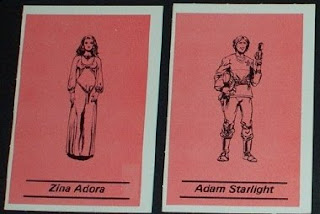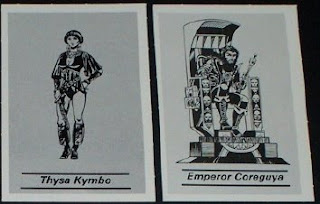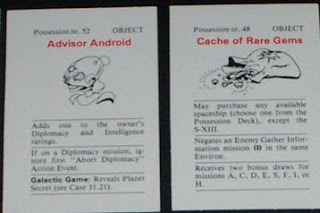(Yes, I know, I'm starting over. And restarting a bit late. But hey, it's my blog; I'll do it if I want to.)
So for my upcoming Freedom in the Galaxy/Worlds of Wonder game, I've decided that A is for Awesome.
I've come up with campaign ideas before, but the big problem with virtually all of them is that the player characters won't come up against the really cool stuff until they're higher level -- sometimes much higher level. That takes time. And it can be dull getting there.
Besides, one of my big beefs with class/level games is that you pretty much want to start at first level so the character can "grow".
Screw that.
For this game, I want the characters to be grown already. Like starting out a D&D game at 5th level (or even higher). I don't want bumbling newbies, kids barely old enough to shave, trying to save the universe! I want professionals, sickened by the excesses of a corrupt Empire, willing to risk all to bring Freedom to the Galaxy.
So I've decided to go with pre-generated characters, based on the characters in the game.
Some will cry foul; rolling up one's own character is some sort of gawd-given right. Maybe. But they might turn out to be a putz. My way, every character has something going for him or her. (And speaking of her, what the heck is up with the entire Star Wars series? why is it that I can count the number of female characters on the fingers of one hand? But I digress.)
And the beautiful thing is, you don't have to play the same character every time. Say you come to every session. One time, you pay Rayner Derban. But the next time, Derban isn't even on the mission! What to do? Play another character, of course!
(I admit, this might cause problems. But I hope it won't.)
Anyway, these guys are going to be a bit over-the-top. And that's great. Roleplaying is supposed to be escapist. Just be glad you didn't have to work your way up to it from first level!
So, to summarize and to get to the title of this post: I'm going to be embracing the blog post "
How to Awesome Up Your Players" from the awesome
Jeff's Gameblog.
I've always been more restrictive than permissive in my GMing. And I see now that I don't want to be. So I'm making a conscious effort to do this.
Bonus post!
I didn't really jump on the A to Z bandwagon like a number of other old school bloggers did. I don't think that way, for one thing, and I have a hard time completing long projects like that.
But I'm thinking it might be good for me.
Plus, I got some good feedback on my last post, which gets me all juiced up to get started.
So, A is also for:
All right, let's do this thing!First of all, I have to admit that I finally understood something about myself after my last post. When I asked if it was a stupid idea, I didn't mean for
someone to do this, I mean for
me, specifically to do this. I didn't realize it at the time. I chalked it up to a standard self-effacing "I'm not special" kind of thing.
But it was actually a real concern. As near as I can tell (without a formal diagnosis), I have ADHD. This results in problems in undergoing long-term projects and the like. I've had this all my life, but only recently realized that that's what it is. It makes so much sense out of so many things that have happened to me/that I've done.
But I refuse to let it be a handicap! I'm going to do this thing, because I believe in it and because some of my favorite bloggers have responded positively to it. I'll finally be running the game I want to run.
Y'see (if you'll pardon the digression), every time I've run a game I've pretty much run it straight out of the box. I take the designer's word for how to do things, and usually run the enclosed scenario (if there is one -- and I can't recommend the one from LotFP:WFRPG enough, it's a doozy!)
I've never "rolled my own" as so many of the old school have. This gives me the chance to do that.
I put together a list earlier of some of the many things I'll need to address. Here's a partial list:
Aliens
Professions
Character Conversion
Spaceship rules
Army rules
Environments (*)
Equipment
and the list goes on.
(*: Environments is a special one from FitG; each world may have one or more of the following:
Urban, Wild, Liquid, Subterranean, Air and Fire -- each of which has its own characteristics)
Okay, just that list almost overwhelmed me. I knew if this was to work I'd need a powerful ally. And I have one: The humble 3x5 card. Anything important gets a 3x5 card. If it doesn't fit, it needs to be broken down into smaller things. (I may not be able to write a 128 page worldbook, but by gawd I can write a 3x5 card!) Focus is the key.
So, when I run this, expect to see my 3x5 card box at the table. It'll be my constant companion, my memory, my campaign-in-a-box.
It just might make things even possible. Because I really want this to happen.
(Hmm, now what the heck to I do for a "B"?)






